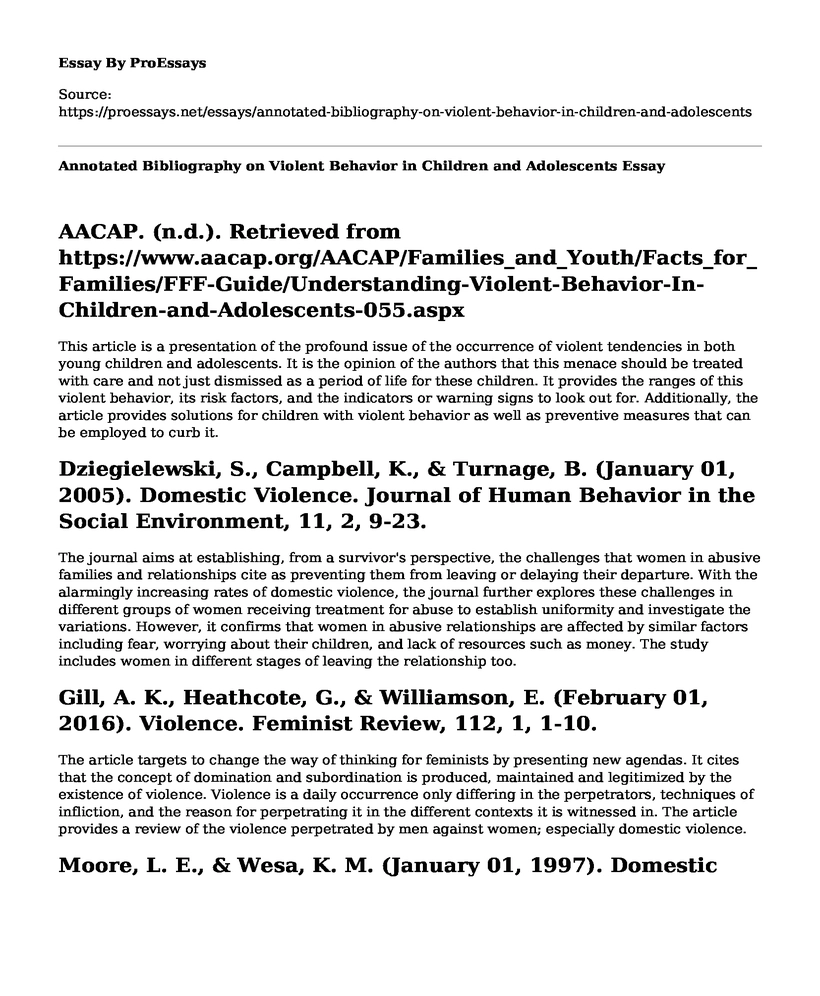AACAP. (n.d.). Retrieved from https://www.aacap.org/AACAP/Families_and_Youth/Facts_for_Families/FFF-Guide/Understanding-Violent-Behavior-In-Children-and-Adolescents-055.aspx
This article is a presentation of the profound issue of the occurrence of violent tendencies in both young children and adolescents. It is the opinion of the authors that this menace should be treated with care and not just dismissed as a period of life for these children. It provides the ranges of this violent behavior, its risk factors, and the indicators or warning signs to look out for. Additionally, the article provides solutions for children with violent behavior as well as preventive measures that can be employed to curb it.
Dziegielewski, S., Campbell, K., & Turnage, B. (January 01, 2005). Domestic Violence. Journal of Human Behavior in the Social Environment, 11, 2, 9-23.
The journal aims at establishing, from a survivor's perspective, the challenges that women in abusive families and relationships cite as preventing them from leaving or delaying their departure. With the alarmingly increasing rates of domestic violence, the journal further explores these challenges in different groups of women receiving treatment for abuse to establish uniformity and investigate the variations. However, it confirms that women in abusive relationships are affected by similar factors including fear, worrying about their children, and lack of resources such as money. The study includes women in different stages of leaving the relationship too.
Gill, A. K., Heathcote, G., & Williamson, E. (February 01, 2016). Violence. Feminist Review, 112, 1, 1-10.
The article targets to change the way of thinking for feminists by presenting new agendas. It cites that the concept of domination and subordination is produced, maintained and legitimized by the existence of violence. Violence is a daily occurrence only differing in the perpetrators, techniques of infliction, and the reason for perpetrating it in the different contexts it is witnessed in. The article provides a review of the violence perpetrated by men against women; especially domestic violence.
Moore, L. E., & Wesa, K. M. (January 01, 1997). Domestic violence. Primary Care Update for Ob/gyns, 4, 6, 257-260.
This article emphasizes the importance of integrating care models that cater to depression in women. It further documents that improving the quality of the method of collaborative depression care significantly improves the outcomes of care in women.
Martin, Z. J. (2009). The mindless menace of violence: Robert F. Kennedy's vision and the fierce urgency of now. Lanham: Hamilton Books.
The author here aims at creating awareness on how when people abandon their duties and responsibilities, and they try to rationalize their actions. The book further adds that if the vision presented by Robert F. Kennedy were to be followed, a better nation would be born through social regulation with a reduced tolerance for domestic violence as well as other forms of violence.
Seymour, K. (2018). "Cowards" and "Scumbags": Tough Talk and Men's Violence. International Journal for Crime, Justice, & Social Democracy, 7(4), 132-147.
The article is aimed at investigating the different ways through which violence, and especially violence against women, is usually cited in attempts of preventing its occurrence in Australia. It explores how the linking of violence to specific groups of people and the use of harsh responses only serve to enhance the perpetration of violence against women.
Thoreau, H. D. (1905). Life without principle (No. 18). AC Fifield.
This essay by Thoreau is a representation of what he considers to be his program of beliefs for perfect of righteous living.
References
AACAP. (n.d.). Retrieved from https://www.aacap.org/AACAP/Families_and_Youth/Facts_for_Families/FFF-Guide/Understanding-Violent-Behavior-In-Children-and-Adolescents-055.aspx
Dziegielewski, S. F., Campbell, K., & Turnage, B. F. (2005). Domestic violence: Focus groups from the survivors' perspective. Journal of human behavior in the social environment, 11(2), 9-23.
Gill, A. K., Heathcote, G., & Williamson, E. (2016). Introduction Violence. Feminist Review.
Moore, L. E., & Wesa, K. M. (1997). Domestic violence. Primary Care Update for Ob/gyns, 4, 6, 257-260.
Martin, Z. J. (2009). The Mindless Menace of Violence: Robert F. Kennedy's Vision and the Fierce Urgency of Now. University Press of America.
Seymour, K. (2018). 'Cowards' and 'Scumbags': Tough Talk and Men's Violence. International Journal for Crime, Justice and Social Democracy, 7(4), 132-147.
Thoreau, H. D. (1905). Life without principle (No. 18). AC Fifield.
Cite this page
Annotated Bibliography on Violent Behavior in Children and Adolescents. (2023, Jan 04). Retrieved from https://proessays.net/essays/annotated-bibliography-on-violent-behavior-in-children-and-adolescents
If you are the original author of this essay and no longer wish to have it published on the ProEssays website, please click below to request its removal:
- Paper Example on Role of Indira Gandhi in Restoring Peace in India
- Essay on School Shootings and Ways to Prevent Them
- Effects of Alcohol on Academic Performance Among College Students Paper Example
- Stop Wearing and Buying Fur Clothes Essay Example
- Drug Abuse, Racial Injustice & The War on Drugs - Research Paper
- Essay Sample on Dark Skin Women and Beauty Standards: Discrimination & Praise
- Children Who Have Experienced Abuse - Research Paper Sample







